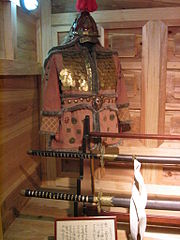
Gaya armour and helmet (5th century)
Korean armour is the armour used traditionally in ancient times against swords in swordfighting, and as well in other battlefield encounters by Koreans or those fighting in Korea, or Korean fighting overseas. Related to the battle needs accompanying Korean swords and also including Korean horse-armour and other kinds of early anti-ballistic armour before the 20th century.
Introduction[]

Korean armour
Korean armour were generally scale armours consisting of: vest, pauldrons, skirting; with groin and/or underarm protections. Kings and nobles would also wear shoulder protections. Mesh armours developed late in Korean warfare as piercing weapons for up close fighting were rarer than slashing and striking edged weapons. Shields protected against arrows for infantry.
Korean armour tended to be of one piece, somewhat similar in appearance to costume of that time. In the fog of battle it was essential that Korean armour be distinguished quickly from the multi-piece Chinese armour and the leather and metal-studded Mongolian armour. Korean armour was designed to allow fast kicks, ground fighting, and upward strikes while Chinese armour was designed for downward strikes, and more positionary warfare (This is merely a generalization since both cultures have had extensive evolution in warfare through the ages).
To some extent Chinese military tactics were designed for attacks and attacking from height downwards onto the enemy; and Korean for attacks from below with the Koreans commanding heights on mountains, strategic chokehold passes, and mountain fortresses or seong, with attackers and arrows moving upwards. This was naturally dictated by the Chinese plains past the Yalu river, and the Korean mountain ridges and passes inland which were the historic battlegrounds. The armour responded to both these needs.
Goguryeo Armour[]
Goguryeo armour was a type of lamellar armour, made of little steel plates woven together to make a flexible shirt. It was effective against arrows, swords, and spears.
Sino-Korean brigandine from Goryeo to Joseon dynasty[]
Effective against ranged attacks, this style of brigandine continued til the late 19th century. Ballistic attacks required different materials.
Joseon dynasty armour[]

Armour exposed at the Danghangpo Battle memorial site.
Armour from the Joseon dynasty consisted of a heavy canvas coat with iron plates on the inside. The iron plates held together by iron studs that were visible on the outside.
Two notable types were "dujeong-gap"(두정갑) and "durumagi"(두루마기). Both bore similar resemblance, except for the fact that the durumagi had additional scale armour.
See also[]
- Korean sword
- Korean knife
- Korean martial arts
- Plated mail - armours similar to Gyeongbeongap (경번갑/鏡幡甲)
External links[]
- Silk Road Designs Armoury --Brigandine
- Silk Road Designs Armoury --Armours of Scales
- Korean Armour
- Armor from Goryeo Dynasty
- Iron Armour
- about Korean plated mail (lang. Korean)
The original article can be found at Korean armour and the edit history here.